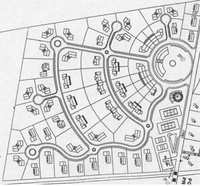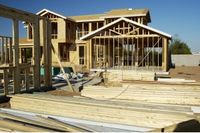

If you want to be far from the madd(en)ing crowd, you can buy a plot and have a house built for you. The number of new builds in France is increasing by almost 50 per cent per year (the vast majority of them in Provence-Alpes-Côte-d’Azur).
You can choose to have a home built to your own design or to a standard design provided by a nationwide building company such as Maison Bouygues Immobilier (http://www.bouygues-immobilier.com ) or a small local builder (constructeur). You can even buy a ‘kit’ house, offered by a number of firms for installation in France. Although French builders have a range of standard designs, they will accommodate almost any interior or exterior variations (for a price), provided they’re permitted under the local building regulations. If you literally want to build your own home (known as auto-construction), you might want to join an association called Savoir Faire et Découverte (08 20 82 01 86, http://www.lesavoirfaire.com ), which organises ‘hands-on’ days, weekends and courses with expert tradesmen in 11 regions (listed on the website).
Building your own home is becoming an increasingly attractive option as the price of property and of renovation increases. It allows you not only to choose the design of your home, but to ensure that the quality of materials and workmanship are first class. Other benefits of building your own home can include better integration into the community (provided you use local tradesmen), rapid improvement in your command of French, enjoyment and the satisfaction of realising a dream. On the other hand, it can take longer and cost more than expected and there can be frustrations and disappointments. In any case, building your own home isn’t a project to be undertaken lightly.

Building plots (terrains à bâtir or terrains constructibles) are available in most areas of France. Plots range from around 400m2 to several hectares, the average plot being between 1,000 and 3,000m2 (around half an acre to an acre). They can be bought through estate agents or directly from the owner (e.g. a farmer). Builders usually also have a selection of plots for sale or know of plots that are available. Most builders offer package deals that include the land and the cost of building a home. However, it isn’t always advisable to buy the plot from the builder who’s going to build your home and you should shop around and compare separate land and building costs. If you do decide to buy a package deal from a builder, you must insist on separate contracts for the land and the building and obtain the title deed for the land before signing a building contract.
Sometimes a batch of plots (lotissements) is released by a communal authority, although priority is often given to local people. In these cases, there are often specific restrictions as to the type and size of property that can be built. There are a number of websites listing plots for sale, including http://www.achat-terrain.com and http://www.terrain.fr .
You must take the same care when buying land as you would when buying a home, particularly regarding local development plans and planning permission. You can apply for official confirmation that the land may be built on, a certificat d’urbanisme, which should provide the necessary information. A certificat d’urbanisme is often equated with ‘outline planning permission’ in the UK, but in fact it doesn’t confer any specific building permission; it merely confirms that the land has been ‘zoned’ for residential use.
The application form (demande de certificat d’urbanisme) must be accompanied by four copies of plans as described above as well as a description of the property. Confirmation (or denial) should be granted within two months and, once it has been granted, you can apply for a building permit for the construction you propose, which must be done within a year of obtaining the certificat d’urbanisme.
Never assume that you will be able to build the same sort of house as your neighbours, as regulations vary according to the situation and type of plot or the rules may have changed since other homes were built. Don’t rely on the builder or developer to check for you, but do so yourself or have your lawyer do it. If a mistake is made, a building may need to be demolished!
Also check the maximum permitted size of a building on the plot; all too often, foreign buyers have found themselves the proud owners of a rustic plot on they cannot build anything larger than a shed!
Before you buy land, particularly in rural areas, you should take advice from a professional (preferably a lawyer) who should thoroughly investigate the conditions and regulations affecting the land.
Never believe an owner or estate agent who is keen to sell you a plot and says that there will be ‘no problem’ getting planning permission, but check with the local town hall and make it a condition of the purchase of a building plot.
Some plots are unsuitable for building as they’re too steep, rocky or sandy and therefore require prohibitively expensive foundations (it’s wise to take a soil sample). It’s wise to consider the access to a plot if this isn’t via a surfaced road. Rainfall in some areas can be torrential and many tracks turn into impassable mud baths and some are even washed away. It’s a good idea to consult an architect, who will be able to tell you whether the plot is suitable for construction. You should also have a land survey of the plot before you commit yourself to a purchase.
You should also check (at the mairie) the local plan d’occupation des sols (POS) of the land on which the property stands. The POS specifies a ‘land occupation coefficient’ (coéfficient d’occupation des sols/COS), which indicates the proportion of the land that may be built on. If the COS is 0.5, for example, and the plot is 1,000m2, you may build a 500m2 home on it. The area of a dwelling is called the surface hors oeuvres nette (SHON) and includes all habitable areas except lofts (unless converted to rooms), basements (unless used for living), balconies and terraces.
Note also that the cost of providing services to a property in a remote rural area may be prohibitive, and it must have a reliable water supply. If you don’t have mains water and have to rely on other sources such as wells, you should make sure that the supply will be adequate for your needs.
Finally, if you yearn for a cottage on the seafront, note that the Loi littoral prohibits all building within 100m (330ft) of the French coast.
Land prices vary enormously according to location and whether main services are connected. A plot with mains connections (e.g. electricity, gas, telephone, water and sewerage) is said to be viabilisé and you should check which services, if any, are available, as it can be very expensive to have a plot connected to the mains. Land in or near a small village, where there’s no mains drainage, can be bought for less than €5 per m2 (€50,000 per hectare) whereas land with connections to all services, including water and telephone, near a popular town can cost as much as €100 per m2 (€1m per hectare), the average cost being around €7 per m2 (€70,000 per hectare). The average plot (between 1,000 and 3,000m2) costs between €10,000 and €40,000. If you have school-age children, you may even qualify for a grant, as many small communes are keen to boost local school numbers! (Note that agricultural land can be bought for as little as per €0.50 per m2/€5,000 per hectare, but you won’t be allowed to build on it!)
Building costs range from around €500 per m2 in an average area to €1,500 (or more) per m2 in resorts, depending on the design and the quality of construction. Note, however, that you should add an extra 10 to 15 per cent to the estimated price, as the actual cost is always higher than the original budget. Note also that labour costs may be considerably higher if your plot is situated in a remote area, where you will also have to pay extra for transporting materials. Value added tax at 19.6 per cent is payable on new buildings and in some communes you must pay a taxe locale d’équipement (TLE). Shop around and compare prices, which can vary considerably (small family builders often provide the best value).
Before accepting a quotation, it’s wise to have it checked by a building consultant to confirm that it’s a fair deal. You should also check whether the quotation (which must include VAT) is an estimate or a fixed price, as sometimes the cost can escalate wildly due to contract clauses and changes made during building work.
Generally, you can expect your total costs to break down roughly as follows: land 25 per cent; building 40 per cent; interior fittings 25 per cent; garden 5 per cent; professional fees 5 per cent (minimum).
If you’re buying land for building, you should make it a condition of the purchase that a building permit is granted; otherwise, you could be forced to buy land on which you cannot build.
If you’re having a home built to your specifications, you should ensure that the building contract includes the following:
Tip: It isn’t uncommon to have problems during construction, particularly regarding material defects, so it’s vital to have a contract checked by a lawyer, as building contracts are often heavily biased in thebuilder’s favour and give clients very few rights.
If you’re buying a property in a development off plan (en état futur d’achèvement), the developer should provide a standard contract.
If you’re designing your own home or working with an architect to come up with a bespoke design, think carefully about the following:
When looking for an architect or builder, it’s wise to obtain recommendations from local people you can trust, e.g. a notaire, local mayor or neighbours. Professionals aren’t always the best people to ask, as they may receive a commission. Always obtain references (e.g. from previous customers) before employing either.

All qualified tradesmen (artisan) living in France must be registered at the local town hall (mairie) and have a SIRET number, although you should also check that a builder has a ten-year guarantee certificate (garantie décennale). It’s usually better to use a local building consortium or contractor (entrepreneur) rather than a number of independent tradesmen, particularly if you won’t be around to supervise them, although it will cost you a bit more; coordinating individual artisans can be nightmare. On the other hand, if you do it ‘yourself’ using local hand-picked tradesmen, you can save money and learn a great deal into the bargain.
Most architects offer three levels of service: design; tendering and contracting; and project management. A good architect should be able to recommend a number of reliable builders, but you should also do your own research, as the most important consideration when choosing a new home is the reputation (and financial standing) of the builder. You should be wary of an architect with his ‘own’ builder (or a builder with his own architect): as it’s the architect’s job to ensure that the builder does his work according to the plans and specifications, you don’t want their relationship to be too cosy! Inspect other homes the builder has built and check with the owners as to what problems they’ve had and whether they’re satisfied. Note that building standards in France vary considerably and you shouldn’t assume that the lowest offer is the best value.
Tip: Your best insurance when building a property is the reputation of the builder and his liquidity.
Details of French builders can be obtained from the Fédération Maisons de Qualité (http://www.maisons-qualite.com ). A register of architects is kept by the Conseil National de l’Ordre des Architectes (http://www.architectes.org ).
French law requires a builder to guarantee his work against structural defects for ten years (garantie décenniale). An architect is also responsible for ten years for defects due to poor supervision, incorrect instructions given to the builder, or problems caused by poor foundations, e.g. subsidence. On completion, a builder must provide a ‘perfect completion guarantee’ (garantie de parfait achèvement) covering minor defects that may appear during the year after completion, such as cracks in plaster, and a ‘good functioning guarantee’ (garantie de bon fonctionnement), valid for two years, covering systems such as plumbing and electrical installations. You should have a completed building checked by a structural surveyor for defects and a report drawn up. If there are any defects, he should determine exactly who was responsible for them.
It’s also important that the builder provides a ‘termination’ guarantee (backed by a bank or insurance company) to cover you in the event that he goes bust before completing the property and its infrastructure, which must be specified in the contract.
If you want a house built in France exactly to your specifications, you will need to personally supervise it every step of the way or employ an architect or engineer to do so for you. Without close supervision it’s highly likely that your instructions won’t be followed. Note that it isn’t uncommon to have problems during construction, particularly regarding material defects. Read the small print of a contract before signing it to ensure that you know exactly what you’re getting for your money and, more importantly, what you aren’t getting. Some contracts include only the building ‘shell’ and not the interior or exterior finish.
If you have a problem with an architect, builder or contractor, you must usually be extremely patient and keep calm when trying to resolve it and should keep a record of every conversation and take relevant photographs as evidence.

Just as it’s possible to buy self-build furniture, you can buy a self-build or kit home (une maison à monter soi-même or une maison kit), although assembly is rather more complicated than that of a chest of drawers and requires considerable construction experience and expertise. Kit suppliers can often erect your house for you, or you can find a local company to do so.
Kit houses come in a variety of shapes, sizes and designs, must most are timber-framed. You can choose from a set of standard designs or design your own home in conjunction with the builder, although you’re limited by the size of elements that will fit in a lorry.
A timber frame can be erected in three to five days and a house completed in around ten weeks, although you should allow three months from the laying of the foundations (concrete takes around two weeks to set).
A timber-frame house costs around €1,000 per m2 (for example, a three-bedroom house covering 100m2 costs around €100,000), and professional construction an extra €250 per m2.
There are a number of French companies specialising in timber frame houses, including the following:
Major UK suppliers of kit homes include the following:
If you want your home put together by a local (i.e. French) construction company, choose one that’s affiliated to AFCOBOIS (http://www.maisons-bois.org ), a not-for-profit organisation whose aim is to promote wooden home construction, or the house-builders’ union, the Union Nationale des Constructeurs de Maisons Individuelle UNCMI (http://www.uncmi.org – regional office addresses and telephone numbers are listed on the website).
Further information about self-build houses is available from the following organisations and publications:
Chalets et Maisons Bois, Le Journal du Bois and Plans de Maison, published by Bois Editions.
This article is an extract from Buying a home in France. Click here to get a copy now.